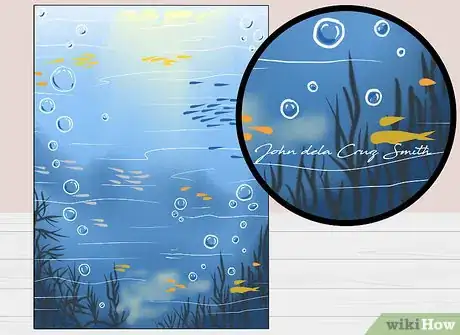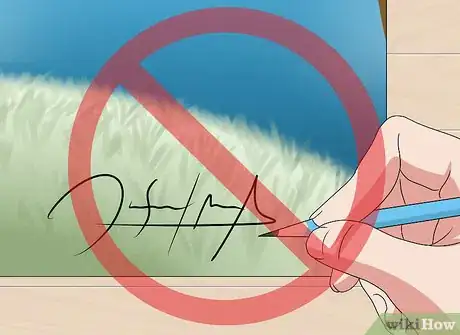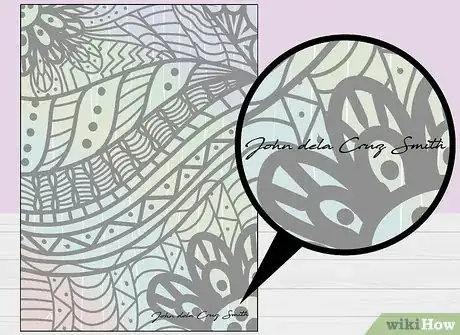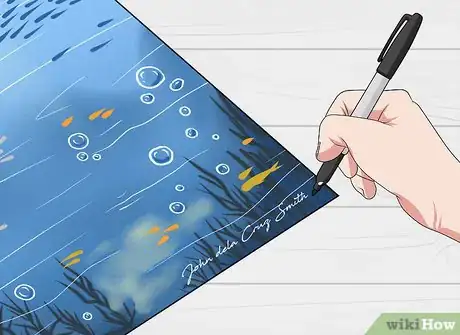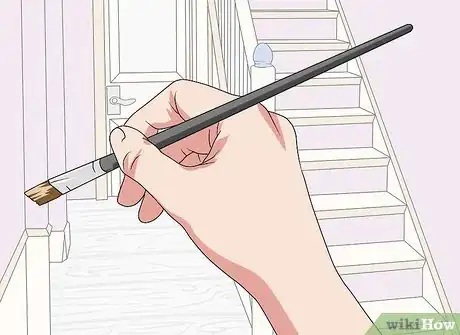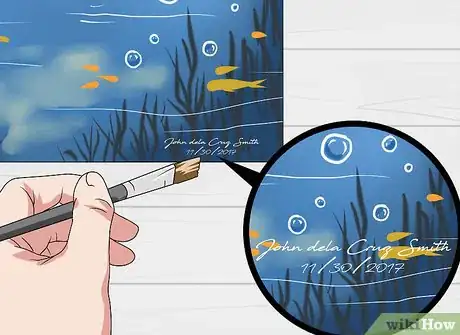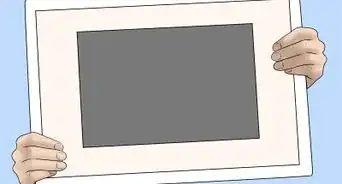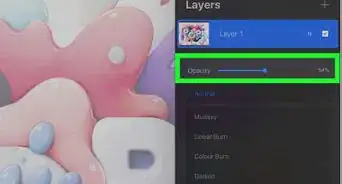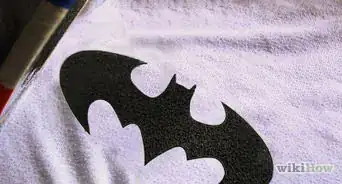This article was co-authored by Jeanine Hattas Wilson and by wikiHow staff writer, Kyle Hall. Jeanine Hattas Wilson is a Professional Painter and the President of Hattas Public Murals, Inc. With nearly 20 years of experience, Jeanine specializes in creating, overseeing, designing, and painting murals. Jeanine holds a BA in Advertising from Marquette University and a Studio Painting Minor from The Milwaukee Institute of Art & Design. She has studied at The Atelier Artien in Paris, France, Los Angeles Academy of Figurative Art, and under renowned artists such as Robert Liberace, Michael Siegel, and William Cochran. To date, Hattas Public Murals has painted nearly 5,000 commissioned works of art in homes and commercial and public spaces.
This article has been viewed 130,587 times.
Adding a signature to your painting will make it easier for people to identify you as the artist, even after your painting has been sold and moved around. The signature on your painting should be legible and clear without being a distraction. You want it to blend in and match the rest of your painting so it doesn't look out of place. By taking the time to come up with a good signature and choosing the right spot for it, you can ensure you get the credit for your artwork that you deserve.
Steps
Coming up with Your Signature
-
1Sign your painting with your full name or last name. Avoid signing with your initials or a monogram or people may not be able to identify you as the artist.[1] Even if some people recognize your initials or monogram now, other people might not, and your painting could eventually become unidentifiable if your full or last name isn't on it.[2]
-
2Use a signature that’s easy to read. If people can’t read your signature, they won’t be able to identify you as the artist. It's true that some famous artists have illegible signatures, but they can get away with it because a lot of people in the art world are familiar with them. If your signature is illegible, future owners of your painting will have a hard time finding out who you are.[3]
- Practice signing a legible signature on a piece of paper. Then, show a few friends and ask if they can read it. If they can’t, work on making it easier to read.
Advertisement -
3Use the same signature on all of your paintings. That way people will start to recognize your signature overtime, which will make your artwork easier to identify. If your signature is always different, people might not realize your paintings were made by the same artist. If you don’t like the signature you’ve used in the past, come up with a new one now and use it on all your future paintings.[4]
-
4Avoid using an eye-catching signature. A signature that is too bold can take away from the rest of your painting. Your signature should be noticeable enough that people looking for it can find it, but not so noticeable that it’s the first thing people’s eyes are drawn to.[5] An easy way to make your signature blend in is to paint it using a color that appears a lot in your painting.[6]
Choosing a Spot to Sign
-
1Sign in a bottom corner of your painting if you want a traditional signature. You can sign in the left or right bottom corner, although signing in the right bottom corner is more common.[7] If you do sign in the bottom corner, place your signature 1–2 inches (2.5–5.1 cm) from the edge of your painting. That way if your painting is framed, your signature won’t be covered up.[8]
-
2Sign somewhere inside of the painting if you want a less obvious signature. You could place your signature inside of an object in your painting, or have it going vertically up the side of something. If you do place your signature inside of your painting, make sure it blends in by keeping it small and using a color that matches the colors around it.[9]
- For example, if your painting features a bowl of apples, you could place your signature inside one of the apples and paint it a shade of red so it blends in.
-
3Put your full name on the back if your signature isn't your full name. Then people can check the back of your painting for your full name if you only have your last name on the front. This will make it easier for someone to identify you as the artist later on.[10]
Adding your Signature
-
1Sign your painting right after you finish it. This will help your signature blend in with the rest of your painting. If you wait for your painting to dry before you sign it, your signature will stand out more and look like it was added later on. Also, collectors prefer paintings where the signature was added at the time the painting was finished because they are harder to forge.[11]
-
2Sign your painting using the same medium you painted it with. Using the same medium will help your signature blend in with the rest of your painting.[12] Avoid using a different medium to sign your signature or it could clash with your painting and look out of place.[13]
- For example, if you used watercolor paints to make your painting, you should use watercolor paints to sign your signature.
- If you made your painting with oil paints, you wouldn’t want to paint your signature with acrylic paint.
-
3Add the year you made the painting to your signature. It will help you and future owners of your art keep track of when it was painted. Right after you sign your name, put the year you made the painting. If you don’t want the year on the front, paint it on the back so people can reference it.[14]
- You can abbreviate the year if you want. For example, instead of signing “2017,” you could just put “17.”
Expert Q&A
-
QuestionCan I sign my painting with a Sharpie?
 Jeanine Hattas WilsonJeanine Hattas Wilson is a Professional Painter and the President of Hattas Public Murals, Inc. With nearly 20 years of experience, Jeanine specializes in creating, overseeing, designing, and painting murals. Jeanine holds a BA in Advertising from Marquette University and a Studio Painting Minor from The Milwaukee Institute of Art & Design. She has studied at The Atelier Artien in Paris, France, Los Angeles Academy of Figurative Art, and under renowned artists such as Robert Liberace, Michael Siegel, and William Cochran. To date, Hattas Public Murals has painted nearly 5,000 commissioned works of art in homes and commercial and public spaces.
Jeanine Hattas WilsonJeanine Hattas Wilson is a Professional Painter and the President of Hattas Public Murals, Inc. With nearly 20 years of experience, Jeanine specializes in creating, overseeing, designing, and painting murals. Jeanine holds a BA in Advertising from Marquette University and a Studio Painting Minor from The Milwaukee Institute of Art & Design. She has studied at The Atelier Artien in Paris, France, Los Angeles Academy of Figurative Art, and under renowned artists such as Robert Liberace, Michael Siegel, and William Cochran. To date, Hattas Public Murals has painted nearly 5,000 commissioned works of art in homes and commercial and public spaces.
Professional Painter Possibly, as long as it doesn't distract too much from the painting. Choose a color that's similar to the base of your painting, so your signature isn't super noticeable.
Possibly, as long as it doesn't distract too much from the painting. Choose a color that's similar to the base of your painting, so your signature isn't super noticeable. -
QuestionWhat size should my art signature be?
 Jeanine Hattas WilsonJeanine Hattas Wilson is a Professional Painter and the President of Hattas Public Murals, Inc. With nearly 20 years of experience, Jeanine specializes in creating, overseeing, designing, and painting murals. Jeanine holds a BA in Advertising from Marquette University and a Studio Painting Minor from The Milwaukee Institute of Art & Design. She has studied at The Atelier Artien in Paris, France, Los Angeles Academy of Figurative Art, and under renowned artists such as Robert Liberace, Michael Siegel, and William Cochran. To date, Hattas Public Murals has painted nearly 5,000 commissioned works of art in homes and commercial and public spaces.
Jeanine Hattas WilsonJeanine Hattas Wilson is a Professional Painter and the President of Hattas Public Murals, Inc. With nearly 20 years of experience, Jeanine specializes in creating, overseeing, designing, and painting murals. Jeanine holds a BA in Advertising from Marquette University and a Studio Painting Minor from The Milwaukee Institute of Art & Design. She has studied at The Atelier Artien in Paris, France, Los Angeles Academy of Figurative Art, and under renowned artists such as Robert Liberace, Michael Siegel, and William Cochran. To date, Hattas Public Murals has painted nearly 5,000 commissioned works of art in homes and commercial and public spaces.
Professional Painter Make your signature large enough to be seen, but not so large that it's incredibly noticeable. People should be able to find it, but it shouldn't be in their face.
Make your signature large enough to be seen, but not so large that it's incredibly noticeable. People should be able to find it, but it shouldn't be in their face. -
QuestionWhat about digital art?
 Community AnswerIf you are using a stylus on a touchpad, then you should be able to sign your name easily. Otherwise, you can make a professional looking signature by writing it on paper and scanning it onto the computer. After that, open it as a file, and resize on top of your drawing. It takes more time, but it will be reusable for your future art.
Community AnswerIf you are using a stylus on a touchpad, then you should be able to sign your name easily. Otherwise, you can make a professional looking signature by writing it on paper and scanning it onto the computer. After that, open it as a file, and resize on top of your drawing. It takes more time, but it will be reusable for your future art.
References
- ↑ Jeanine Hattas Wilson. Professional Painter. Expert Interview. 11 May 2021.
- ↑ http://www.artbusiness.com/signart.html
- ↑ http://www.artbusiness.com/signart.html
- ↑ http://www.artbusiness.com/signart.html
- ↑ Jeanine Hattas Wilson. Professional Painter. Expert Interview. 11 May 2021.
- ↑ http://www.artpromotivate.com/2012/01/how-to-sign-painting-or-drawing.html
- ↑ Jeanine Hattas Wilson. Professional Painter. Expert Interview. 11 May 2021.
- ↑ http://www.artpromotivate.com/2012/01/how-to-sign-painting-or-drawing.html
- ↑ http://thevirtualinstructor.com/blog/how-to-sign-artwork
- ↑ http://www.artbusiness.com/signart.html
- ↑ http://www.artbusiness.com/signart.html
- ↑ Jeanine Hattas Wilson. Professional Painter. Expert Interview. 11 May 2021.
- ↑ http://www.artbusiness.com/signart.html
- ↑ http://www.artbusiness.com/signart.html
About This Article
To sign your painting, come up with a legible signature so others can identify it, and blend it in with the artwork. Use either your last name or full name as your signature, since your initials might not be recognizable enough. For a traditional signature, place it in the bottom right- or left-hand corner of your work. Alternatively, you can write your name on the back of the painting, or even include it inside an object you’ve painted. Use the same medium for your signature you used for your work of art so it blends in. If you decide to put your signature inside an object in your painting, keep it small so it doesn’t overshadow your work. For tips on how to practice your signature, keep reading!
